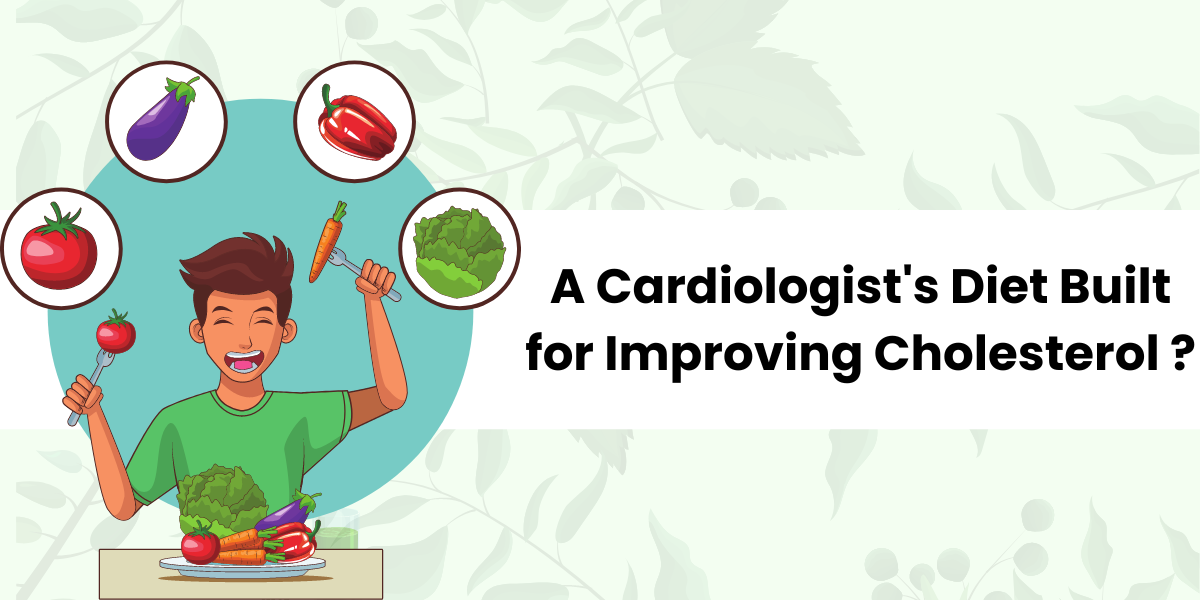A Cardiologist’s Diet Built for Improving Cholesterol

Your liver produces cholesterol, a chemical required for the synthesis of hormones, vitamin D, and bile salts, which aid in digestion. The two main types of this substance that resembles fat are HDL (high-density lipoprotein) and LDL (low-density lipoprotein). The more HDL, also referred to as “good cholesterol,” you have, the better.
You should maintain low levels of LDL, sometimes known as “bad cholesterol,” in your body. LDL cholesterol levels specifically should be less than 100 mg/dL, while values between 100 and 129 mg/dL are appropriate for people with no obvious health issues. LDL levels between 130 and 159 mg/dL are classified as “borderline high,” 160 to 189 mg/dL are “high,” and 190 mg/dL or more is “extremely high.”
Middle-aged and older persons are frequently affected by high cholesterol. High cholesterol is, however, very typical in persons in their 20s and 30s. The Centers for Disease Control and Prevention estimate that over 95 million adults aged 20 and older have blood cholesterol levels that are at or above 200 mg/dL.
Cholesterol Levels in Young Adults
Total Cholesterol: Young adults are generally regarded as healthy if their total cholesterol is under 200 mg/dL. Between 200 to 239 mg/dL of total cholesterol is regarded as borderline high. Total cholesterol is regarded as excessive and hazardous if it is 240 mg/dL or more.
Bad cholesterol: LDL cholesterol should have a value of less than 100 mg/dL. Young adults without heart problems may be able to tolerate LDL levels of 100–129 mg/dL. LDL levels between 130 and 159 mg/dL are regarded as borderline high, whereas levels of 160 mg/dL and more are regarded as high and dangerous.
Bad Cholesterol: Young adults may require HDL levels higher than 45 mg/dL. Good cholesterol (HDL): HDL levels should be at least 60 mg/dL. An HDL level below 40 mg/dL can also be a significant risk factor for heart disease.
Risk Factors for High Cholesterol
Young adults are more likely to have high cholesterol if they have certain risk factors, including:
- A history of elevated cholesterol in the family
- A diet heavy in saturated and trans fats
- A sedentary way of life
- Obesity
- Smoking
- excessive alcoholic beverage intake
Although heart disease can be brought on by high cholesterol, the raised level itself has no symptoms. Young adults 20 years of age and older should therefore have their cholesterol examined every five years. It should be highlighted that even persons who are at or below their optimal weight can have high cholesterol, despite the fact that people often equate high cholesterol with being overweight or obese.
High Cholesterol Complications in Young Adults
Even if you manage your high cholesterol before your late 30s, having high cholesterol at an early age can lengthen the duration of the effects you suffer. LDL (bad cholesterol) appears to cause cumulative and irreparable damage to the arteries. A young person’s chance of having cardiovascular disease increases with the length of time they have had high cholesterol.
Lifestyle Changes to Lower Cholesterol
Your cholesterol can be improved by making lifestyle changes. If you already take cholesterol medication, making lifestyle changes will help them intensify their efforts to lower your cholesterol. To reduce your LDL cholesterol, you should:
- Achieve and maintain a healthy weight. Even a few additional pounds can cause elevated cholesterol, and even small changes soon add up. To help you reach a healthier weight, consider implementing some of the modest eating and exercise suggestions below.
- Do the aerobic activity on a regular basis. Regular exercise can assist to increase healthy cholesterol. Exercise five days a week for a minimum of 30 minutes.
- Adopt a balanced diet. Consume a diet that is high in soluble fibre, whole grains, vegetables, fruits, low-fat dairy, and lean protein but low in trans fats and saturated fats.
- Reduce your intake of foods high in carbs. The amount of cholesterol in your body can be influenced favourably by a low-carbohydrate diet. It helps people lose weight by reducing their appetite. Your LDL, total cholesterol, and triglyceride levels will all decrease with weight loss. It can also assist you in increasing your HDL levels.
- Consume good fats. Include healthy fats like monounsaturated fats and polyunsaturated fats in your diet in place of trans fats and saturated fats. These can raise HDL cholesterol levels while lowering LDL cholesterol. Nuts, seeds, fatty fish, and fish oil supplements are good sources of these nutrients for lowering cholesterol.
- Refrain from smoking. Your good cholesterol increases after you stop smoking. Within 20 minutes of quitting, the advantages begin to manifest. Your risk of developing heart disease is half that of a smoker after a year of quitting.
- Consume alcohol moderately. Higher levels of good cholesterol have been associated with moderate alcohol consumption. For women of all ages and men over 65, aim for one drink per day if you wish to drink. Men under 65 are permitted two drinks each day.
- Drink Pomegranate juice. Low-density lipoprotein (LDL), or bad cholesterol, can be decreased by antioxidants. Pomegranate juice has three times as many antioxidants as red wine or green tea. So, try to have a glass of pomegranate juice each day.
High Cholesterol Treatment
A class of medications known as statins is useful in treating high cholesterol in both younger and older persons for those who are unable to lower their LDL levels through lifestyle changes. To assist prevent a cardiovascular event, it’s critical that you take this kind of medication as prescribed.




